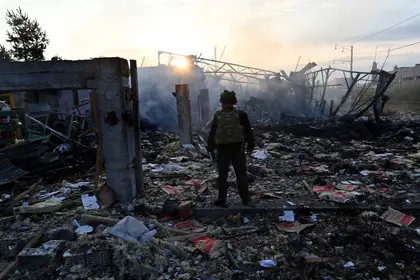Kremlin strike planners targeted something other than Ukraine’s agricultural infrastructure this time, and they used weapons a lot more deadly than imported kit kamikaze drones.
Russian bombers flying in western Russian air space on Thursday launched a total of 43 cruise missiles towards targets in eight regions in Ukraine, Kyiv official statements said. A Ukraine General Staff statement called the strikes “a massive missile attack on the civilian infrastructure of a number of regions.”
JOIN US ON TELEGRAM
Follow our coverage of the war on the @Kyivpost_official.
Approximately half of the missiles were aimed at the capital city of Kyiv, where at least one US Patriot anti-aircraft missile system has been deployed since early summer, and whose airspace is widely accounted to be the best-defended in the country.
Serhiy Popko, head of Kyiv’s military administration, in a statement, said “more than 20 cruise missiles” were launched against Kyiv targets on Thursday.
Kyiv Post reporters positioned at multiple locations around the city during the attacks observed multiple successful intercepts and a few possible ground strikes. The weapons were, according to Popko, a mix of Russian X-101, X-555 and X-55 cruise missiles, all air-launched missiles carrying a warhead of about 400 kg of high explosives.
Cruise missile strikes were likewise reported in Ukraine’s Khmelnytsky, Rivne, Vinnytsia, Lviv and Ivano-Frankivsk regions. Russian missiles also hit Ukraine’s Kharkiv and Chernihiv regions on Thursday, but according to local officials due to shorter ranges, those strikes likely were carried out not by long-range cruise missiles, but by less-accurate, shorter-range S-300 dual-purpose missiles.

Ukraine Tells China that Russia Not Ready for 'Good Faith' Talks
In past weeks Russian strike planners had fired almost no cruise missiles at Ukraine at all, preferring Iranian kamikaze drones instead.
During the first two weeks of September 2023 Russian forces unleashed more than 200 Teheran-designed robot aircraft against Ukrainian targets in almost nightly launches, while over the same period, Russia fired a total of 9 cruise missiles, Kyiv Post research found.
Attacks typical of that strategy took place over 48 hours on Sept. 3-4 with Moscow throwing a reported total of 56 Shahed into the air, almost all of them targeting the Ukrainian Danube River port Reni.
Ukrainian authorities claimed 45 of the Iranian propeller-driven weapons, each carrying an explosive charge eight to ten times smaller than the warhead in an average Russian cruise missile, were shot down.
Russian state media claims the systems are domestically produced “Geran” drones, and not dependent on Iranian assistance. Most independent analysts believe Russia buys the drones in kits and imports them because its aerospace industry cannot produce long-range drones in quantity on its own.
The Thursday strikes focusing on Kyiv and industrial targets elsewhere in the country marked at least a short-term shift from the Kremlin targeting Ukrainian agricultural export capacity in the far southwest.
It was not clear whether impacts on Thursday were intended Russian targets, or missiles knocked down by Ukrainian air defenses en route to Russian targets elsewhere. Ukraine’s Army General Staff (AGS) said its troops shot down 36 incoming missiles.
Ukrainian Air Force spokesperson Yuriy Ihnat in a statement said that all cruise missiles launched by Russian forces on Thursday were dropped from Tu-95 bombers, the famous Cold War-era Bear turboprop capable of carrying as many as 16 cruise missiles dropped from wing pylons or fired with a rotating cylinder in its weapons bay.
The last major mixed drone-missile attack on Ukraine took place on July 19 with at least 30 cruise missiles and 32 drones fired mostly at the Odesa region. Kyiv Post was unable to find reports official or on social media of Shahed drones accompanying the waves of cruise missiles hitting Ukraine on Thursday.
Russia’s Black Sea Fleet (BSF), whose submarines and surface warships have fired Kalibr sea-launched missiles at Ukrainian targets since the outset of the war, and whose platforms have helped hit the Odesa region and grain-handling infrastructure repeatedly since June, according to Ukrainian officials and open-source reports was absent from the Thursday launch operation.
Transfer of BSF warships from the fleet home port in Sevastopol, Crimea intensified following a Sept. 13 Ukrainian missile strike destroying a Russian navy assault ship and missile-carrying submarine, both in drydock. All five of the BSF’s missile-toting Kilo submarines had evacuated Sevastopol port by Sept. 20, multiple reports in both Ukrainian and Russian social media said.
You can also highlight the text and press Ctrl + Enter






